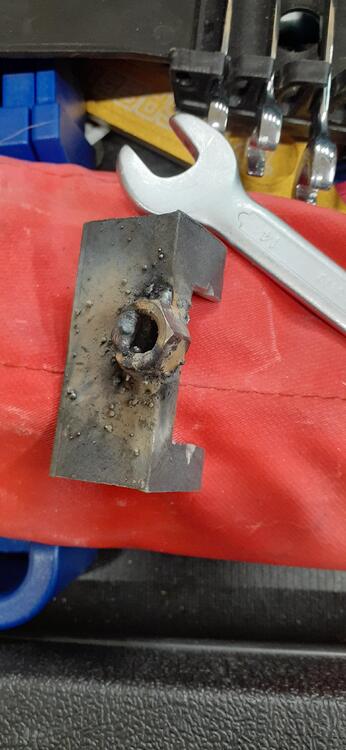Everything posted by SteveJ
-
Flogged with spam calls, HELP!
Of course, not, but we WILL always picture you with a long scraggily beard from here on out.
-
Super Bowl Commercial
- Getting the 73 Back on the Road
And to be clear, it's pronounce as "Yoob".- Getting the 73 Back on the Road
When I played rugby in college, anytime a kick barely made it through the uprights (or doinked through), we would say, "UBE (Ugly, but effective)." That nut is securely fastened to the angle. It's definitely UBE.- Getting the 73 Back on the Road
So, what do you do when you have some free time in the evening, have access to a cheap Harbor Freight welder, and possess a homemade tool? You attach a nut to the tool.- I recently joined this club and have several questions. I am the original owner of a '73 240Z. In 2001, I overhauled the car first by switching out the original carburetors for '71 carbs and removing the points for an electronic ignitionnte.
Oil change - Annual Tires - If you store the car off the ground, you could go several years. If you store the car on the ground, you're probably flat-spotting them. That would push more frequent replacement. I have some friends in my local club that have gone 15+years on a set of tires. I won't trust fate like that. The max for me is 10 years from the manufacture date on the tire and sooner if I detect dry-rot. Remember to pull the tire to inspect the backside of it.- 73 manifold
So, if you don't mind answering, what drove your inquiry?- 73 manifold
The best I can do right now is the full part number: 14004-N3300.- 73 manifold
The exhaust manifold for the 73 was a 1-year only deal. The heat shield is covering up the number on mine.- Looks like I need to replace a Fuel Pump.......
The diaphragm or one of the check valves may be going bad. What brand pump do you have on the car now?- 73 manifold
Intake? Mine has an N33, and I'm pretty sure that it is original to the car.- door holes
My time wasn't wasted. @zKarstold me something about my doors that I didn't know before. I got to do something to address my curiosity, and you got the confirmation you needed. I feel good.- door holes
I think those capture nuts are to hold the brace in place if I understand @zKarscorrectly. I didn't take them out to see if that piece would wiggle inside the door. I'm lazy that way. It's not like there is going to be a thick support in the door since that would intrude on the space for the window & regulator as far as I can tell.- door holes
Hey @gogriz91, do you feel like taking off a door card and seeing if you see the same thing in your door?- Flogged with spam calls, HELP!
- door holes
Since my older siblings pulled enough pranks on me growing up, I didn't get fooled by a snipe hunt because I could smell a rat. 😉- 240z 73' Petronix Ignitor and Flamethrower Issues
I'm hoping he watches the video because I show how it should be wired. If it's wired correctly, then we can proceed with diagnostics.- Looks like I need to replace a Fuel Pump.......
Are you sure your rubber hoses are in good condition? Cracks in the hoses, either in the engine bay or near the tank, could allow air into the hoses. This could prevent the fuel pump from pumping. Don't forget to prime the fuel pump, too, if it's been dry for a while.- door holes
I needed a break from work today, so I went down to the garage. (I do enjoy work-from-home.) I don't know if these photos will help much. It was a challenge getting the camera inside the door. Inside leading edge of the door - you can see the lower two bolts. Lower edge of what I assume is the reinforcement panel Near the door latch It only took a couple of minutes to remove the door card, and no door cards were harmed in the process of getting these photos.- Looks like I need to replace a Fuel Pump.......
I doubt it. The gas would replace the carb cleaner shortly after starting.- Looks like I need to replace a Fuel Pump.......
I used carburetor cleaner recently to spray down the vent lines. That works, too.- 1975 280Z catalytic converter heat shield ?
And this is what I was hinting at with my first post. An emissions station cannot ask you to add equipment to your car that does not conform to how the car was equipped when it left the factory. As an aside, California took that to the extreme. I remember seeing newspaper automotive help columns that pointed out that you couldn't put fuel injection on a car that left the factory with a carburetor, even if it lowered emissions. It wouldn't pass the visual inspection. (I hope that has changed.) And aftermarket parts would need a C.A.R.B sticker, otherwise you would fail.- door holes
You are obviously under the mistaken impression that my door cards are in great shape.- door holes
If I can remember, I can probably take the door panel off this weekend to peek inside.- door holes
Here's what it looks like with the bolts in place. I wasn't looking for what it might be connected to, but I'm guessing that @zKars is on the mark. - Getting the 73 Back on the Road
Important Information
By using this site, you agree to our Privacy Policy and Guidelines. We have placed cookies on your device to help make this website better. You can adjust your cookie settings, otherwise we'll assume you're okay to continue.













